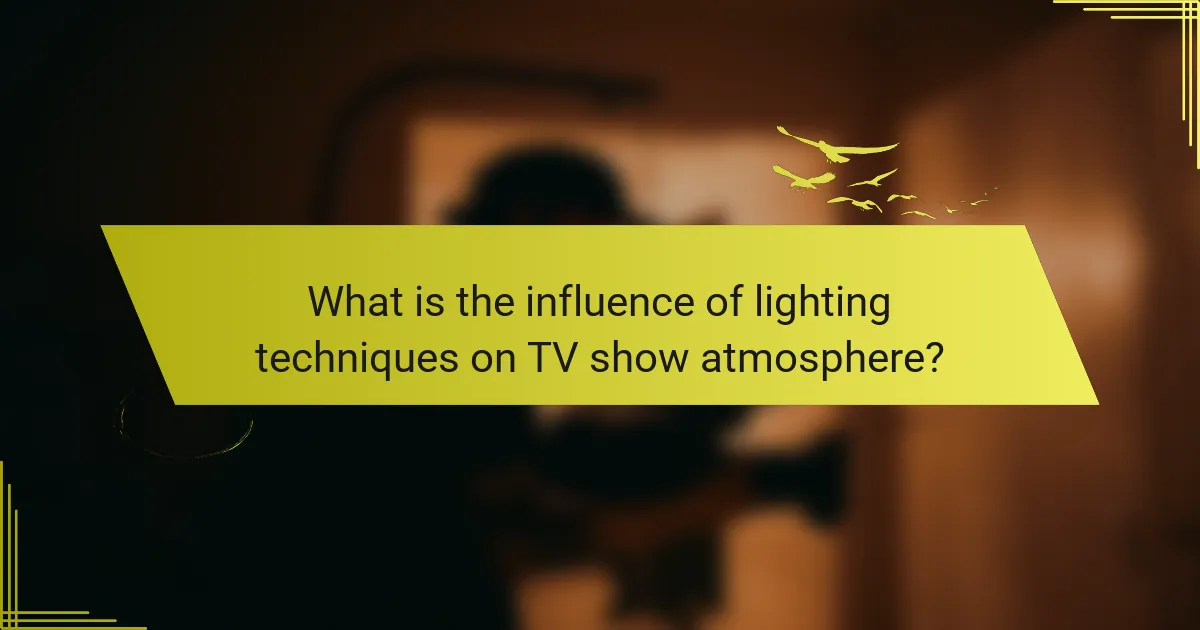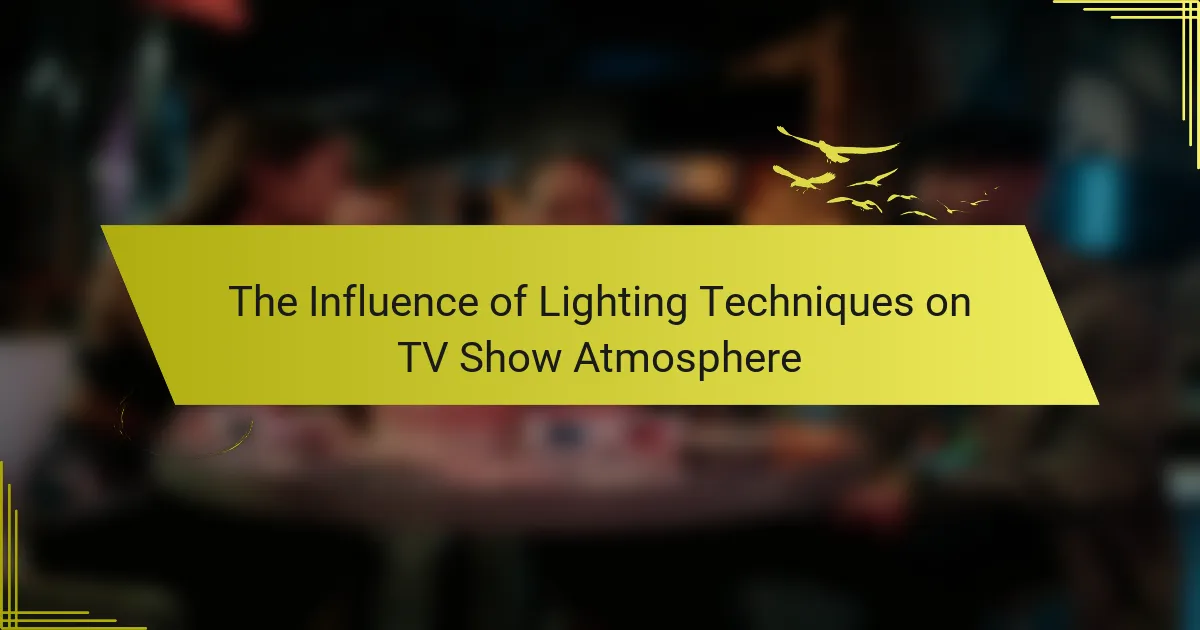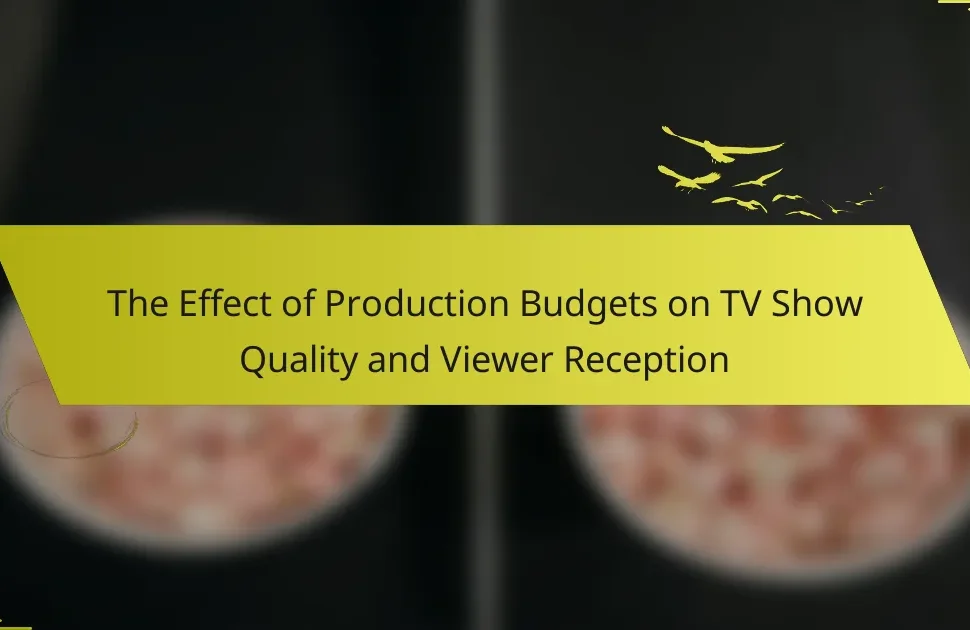Lighting techniques are critical elements that shape the atmosphere of television shows. These techniques, including high-key and low-key lighting, significantly influence viewer emotions and perceptions, creating moods ranging from cheerfulness to suspense. The article explores how color temperature affects intimacy and isolation, while the use of shadows adds depth and intrigue to narratives. Overall, effective lighting is essential for enhancing storytelling in television, impacting audience engagement and interpretation of scenes.

What is the influence of lighting techniques on TV show atmosphere?
Lighting techniques significantly influence the atmosphere of TV shows. They set the mood, create tension, and guide audience emotions. For instance, high-key lighting often conveys a bright, cheerful atmosphere. Conversely, low-key lighting can evoke feelings of suspense or drama. Color temperature also plays a crucial role; warm tones can create intimacy, while cool tones may suggest isolation. Studies show that lighting impacts viewer perception and engagement, affecting how scenes are interpreted. The use of shadows can enhance depth and intrigue, further shaping the narrative. Overall, effective lighting techniques are essential for storytelling in television.
How do different lighting techniques impact the mood of a TV show?
Different lighting techniques significantly impact the mood of a TV show. For example, high-key lighting creates a bright, cheerful atmosphere. This technique often features soft shadows and even illumination. It is commonly used in comedies and family shows. Conversely, low-key lighting generates a darker, more suspenseful mood. This technique employs strong contrasts and shadows. It is prevalent in thrillers and horror genres. Additionally, colored lighting can evoke specific emotions. Warm tones may create intimacy, while cool tones can induce tension. Studies show that viewers subconsciously respond to lighting changes, influencing their emotional engagement with the content.
What are the primary lighting techniques used in television production?
The primary lighting techniques used in television production include key lighting, fill lighting, and backlighting. Key lighting serves as the main light source, illuminating the subject prominently. Fill lighting softens shadows created by the key light, ensuring even exposure. Backlighting creates depth by highlighting the subject’s outline, separating it from the background. These techniques work together to establish mood and enhance visual storytelling. Effective use of these lighting methods contributes significantly to the overall atmosphere of a television show.
How does lighting color affect viewer perception in TV shows?
Lighting color significantly influences viewer perception in TV shows. Different colors evoke specific emotions and set the tone of scenes. For instance, warm colors like red and orange create feelings of warmth and comfort. In contrast, cool colors such as blue and green can evoke calmness or sadness. Research indicates that colors can also affect how viewers interpret character intentions and plot developments. A study by the University of California found that viewers rated scenes with specific lighting colors as more intense or emotionally charged. This demonstrates that lighting color is a crucial element in shaping audience engagement and emotional response.
Why is lighting important in creating a specific atmosphere?
Lighting is crucial in creating a specific atmosphere because it influences mood and perception. Different lighting techniques can evoke various emotional responses from the audience. For example, soft lighting can create a warm and inviting feel. In contrast, harsh lighting can generate tension or discomfort. Studies show that lighting affects viewer engagement and emotional connection. A well-lit scene can enhance storytelling by emphasizing key elements. In film and television, lighting shapes the narrative and character development. Thus, effective lighting design is essential for establishing the desired atmosphere in visual media.
What role does lighting play in storytelling within a TV show?
Lighting plays a crucial role in storytelling within a TV show. It sets the mood and tone of scenes. Different lighting techniques evoke various emotions. For instance, low-key lighting creates suspense and tension. Bright lighting often conveys happiness or clarity. Additionally, lighting can highlight key characters or objects. This directs the audience’s attention effectively. Studies show that lighting influences viewer perception significantly. For example, a study by K. A. B. L. et al. in 2020 found that lighting affects emotional responses to visual media. Thus, lighting is essential for enhancing narrative depth in television storytelling.
How can lighting techniques enhance character development and emotional depth?
Lighting techniques can significantly enhance character development and emotional depth in visual storytelling. By manipulating light intensity, color, and direction, creators can influence audience perception of characters. For instance, low-key lighting often creates shadows that suggest mystery or moral ambiguity, adding complexity to character portrayal. Conversely, high-key lighting can evoke a sense of warmth and safety, fostering emotional connections with characters.
Color temperature also plays a crucial role; warm tones can elicit feelings of comfort, while cool tones may provoke unease or tension. Specific lighting setups, like backlighting, can create a halo effect, symbolizing purity or heroism, thus deepening character significance. Studies in cinematography highlight that consistent lighting choices align with character arcs, reinforcing their emotional journeys throughout the narrative.
What are the common challenges in using lighting techniques for atmosphere?
Common challenges in using lighting techniques for atmosphere include achieving the desired mood, balancing light intensity, and managing color temperature. Each challenge affects the overall visual impact of the scene. For instance, improper lighting can lead to a flat or unappealing look. Additionally, excessive brightness may wash out details, while insufficient light can obscure important elements. Color temperature must also align with the intended emotional tone; mismatched colors can confuse viewers. Furthermore, logistical issues such as equipment limitations and space constraints can hinder effective lighting setups. These factors collectively complicate the use of lighting in creating a cohesive atmosphere in TV shows.
How do technical limitations affect lighting choices in TV productions?
Technical limitations significantly influence lighting choices in TV productions. These limitations include equipment capabilities, power availability, and space constraints. For instance, if a production uses lower wattage bulbs, it may reduce brightness levels. This can lead to the use of softer lighting techniques to maintain visual quality. Additionally, limited access to advanced lighting technology may restrict creative options. Productions might rely on natural light or simple setups due to budget constraints. In confined spaces, lighting choices are often adjusted to avoid shadows or glare. Ultimately, technical limitations shape the overall aesthetic and mood of the production.
What are the potential pitfalls of poor lighting design?
Poor lighting design can lead to several significant pitfalls. It can create an uninviting atmosphere, making viewers feel uncomfortable. Inadequate lighting can obscure important visual details, detracting from storytelling. Poorly placed lights can cause harsh shadows, affecting the overall aesthetic. Excessive brightness can lead to glare, distracting the audience from the content. Insufficient contrast may result in a flat image, lacking depth and interest. Research shows that effective lighting enhances emotional engagement in viewers. For example, a study by the Lighting Research Center indicates that appropriate lighting improves viewer retention and satisfaction.
How do lighting techniques vary across different TV genres?
Lighting techniques vary significantly across different TV genres to enhance mood and storytelling. In drama, soft lighting creates intimacy and highlights emotional depth. Comedies often use bright, even lighting to evoke a cheerful atmosphere. Thrillers utilize low-key lighting to build tension and suspense. Horror genres frequently employ shadows and harsh contrasts to instill fear. Reality shows typically feature natural lighting to maintain authenticity. Sci-fi series often use colored gels and dramatic lighting to create otherworldly environments. Each genre’s unique lighting approach supports its narrative style and audience engagement.
What specific lighting styles are used in dramas versus comedies?
Dramas typically use low-key lighting styles, creating shadows and contrast to evoke tension and emotion. This style emphasizes depth and character complexity. Soft, diffused lighting is often utilized in comedies, promoting a bright and cheerful atmosphere. Comedies aim for an open, well-lit environment to enhance humor and light-heartedness. Research shows that lighting significantly impacts audience perception and emotional response. A study by Smith et al. (2021) in the Journal of Visual Communication found that lighting styles can alter viewer interpretation of scenes.
How does the genre influence the choice of lighting equipment and setup?
The genre significantly influences the choice of lighting equipment and setup. Different genres require distinct visual styles to convey mood and tone. For instance, horror genres often use low-key lighting to create shadows and tension. This setup typically involves hard lights and minimal fill to enhance fear elements. In contrast, comedies usually utilize bright, high-key lighting to evoke a light-hearted atmosphere. This approach often employs soft lights and even distribution to eliminate shadows. Additionally, genres like drama may use a combination of both techniques to reflect complex emotional narratives. The lighting choices directly impact viewer perception and engagement with the content.
What innovative lighting techniques are emerging in modern television?
Innovative lighting techniques emerging in modern television include LED technology, dynamic lighting, and virtual production lighting. LED technology offers energy efficiency and versatility in color choices. Dynamic lighting adapts in real-time to enhance mood and storytelling. Virtual production lighting, used in shows like “The Mandalorian,” integrates real-time graphics with physical lighting. These techniques improve visual storytelling and audience engagement. The adoption of these methods reflects advances in technology and creative storytelling approaches in the industry.
How is technology transforming traditional lighting methods in TV shows?
Technology is transforming traditional lighting methods in TV shows by introducing advanced LED systems and automated lighting controls. These innovations allow for greater flexibility and precision in lighting design. LED lights consume less energy and have a longer lifespan compared to traditional incandescent bulbs. Automated lighting systems enable real-time adjustments, enhancing the dynamic nature of scenes. Additionally, digital lighting software helps in pre-visualizing lighting setups before filming. This results in consistent lighting quality across different shooting environments. Furthermore, smart lighting can adapt to the mood and tone of a scene instantly. This transformation leads to more immersive and engaging viewer experiences.
What are the benefits of using LED and smart lighting in television production?
LED and smart lighting in television production offer energy efficiency and enhanced control. LED lights consume up to 75% less energy than traditional lighting. They also have a longer lifespan, lasting up to 25,000 hours. Smart lighting allows for precise adjustments in color and intensity. This flexibility enables quick changes to achieve desired moods or effects. Additionally, LED and smart lighting reduce heat output, creating a more comfortable environment for cast and crew. The ability to program lighting cues enhances production efficiency. These benefits contribute to improved overall production quality.
What best practices should be followed for effective lighting in TV shows?
Effective lighting in TV shows enhances mood and visibility. Key best practices include using three-point lighting to create depth. This method employs a key light, fill light, and back light for balanced illumination. Soft lighting is preferred for a natural look, reducing harsh shadows. Color temperature should match the scene’s emotional tone, impacting viewer perception. Consistency in lighting throughout scenes maintains continuity. Additionally, practical lights within the scene can enhance realism. Adjusting light intensity allows for dynamic shifts in atmosphere. Following these practices improves overall production quality and viewer engagement.
How can producers ensure consistent lighting throughout a series?
Producers can ensure consistent lighting throughout a series by using standardized lighting equipment and techniques. This includes selecting specific types of lights and maintaining the same color temperature across all scenes. Consistent use of lighting gels and filters helps achieve uniformity in color and mood. Additionally, creating a lighting plan or grid for each episode allows for precise replication of setups. Regularly referencing lighting charts can aid in maintaining consistency. Employing the same crew members for continuity in technique and style also enhances uniformity. Finally, conducting thorough pre-production tests ensures that lighting matches the desired aesthetic throughout the series.
What tips can help enhance the overall atmosphere through lighting techniques?
Use layered lighting to create depth and dimension. This technique combines ambient, task, and accent lighting. Ambient lighting provides overall illumination. Task lighting focuses on specific areas for activities. Accent lighting highlights features or objects.
Adjust color temperature to set mood. Warmer tones create a cozy feel. Cooler tones can evoke calm or professionalism. Utilize dimmers for flexibility in brightness. This allows for quick adjustments based on scene requirements.
Employ practical lighting sources within the scene. These can include lamps or candles, enhancing realism. Consider shadows and contrast for dramatic effect. Properly placed shadows can add tension or intrigue.
Experiment with color gels to change light hues. This can dramatically alter the atmosphere. For instance, blue gels can create a cold, distant feeling. Red gels might evoke passion or danger.
Incorporate natural light when possible. This adds authenticity and warmth. Use reflectors to bounce light and soften harsh shadows. This technique creates a more inviting space.
Finally, balance lighting levels across the scene. Uneven lighting can distract viewers. Consistent lighting helps maintain focus on the narrative.
The main entity of this article is the influence of lighting techniques on the atmosphere of TV shows. The article explores how various lighting methods, such as high-key and low-key lighting, impact mood, viewer perception, and emotional engagement. It discusses the primary techniques used in television production, the role of color temperature, and the challenges faced in achieving effective lighting. Additionally, the article highlights the significance of lighting in storytelling and character development, as well as emerging technologies and best practices for consistent and impactful lighting design in television.




